RAINBOW BEAUTY
Volume 7
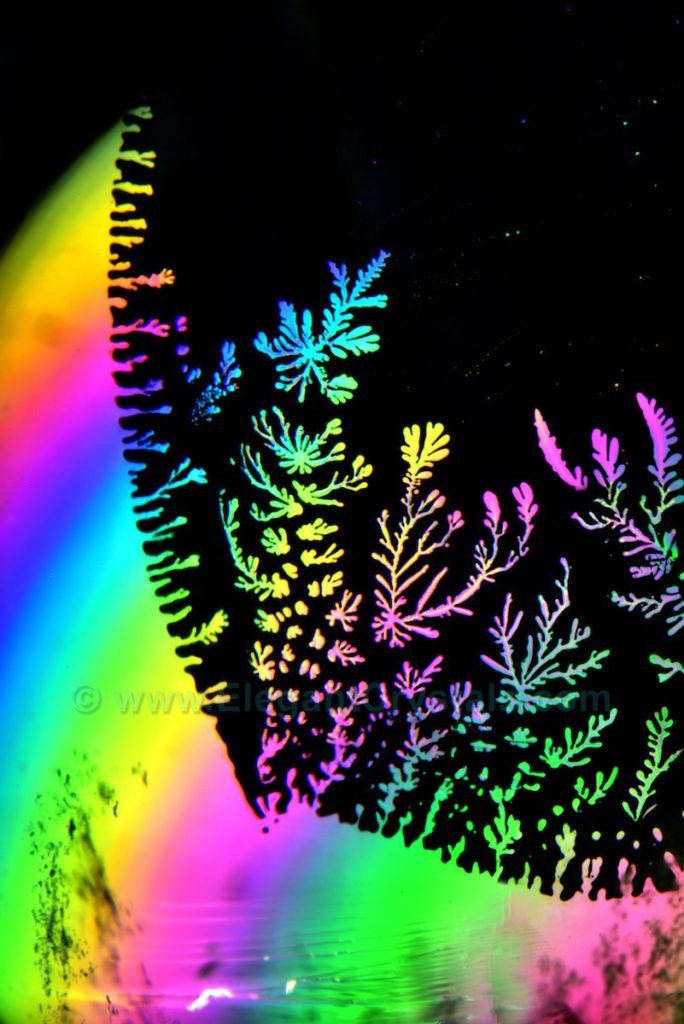
Picture #1
Iris Patterns in Madagascar Quartz
TABLE OF CONTENTS
Copyright Notice
Note to Contributors
Author’s Preface
This book precedes Quartz Rainbow Crystals and Rainbows Forever. They are probably best when read in order:
Rainbow Beauty
Quartz Rainbow Crystals
Rainbows Forever
CHAPTER 1 NATURE’S RAINBOWS
CHAPTER 2 IRIDESCENT WILDLIFE
CHAPTER 3 MINERALS WITH RAINBOWS
CHAPTER 4 NATURALLY FACETED RAINBOW CRYSTALS
CHAPTER 5 POLISHED FACETED RAINBOW CRYSTALS
CHAPTER 6 THE IRIS EFFECT
CHAPTER 7 IRIDESCENT SILICA
CHAPTER 8 AMETHYST RAINBOWS
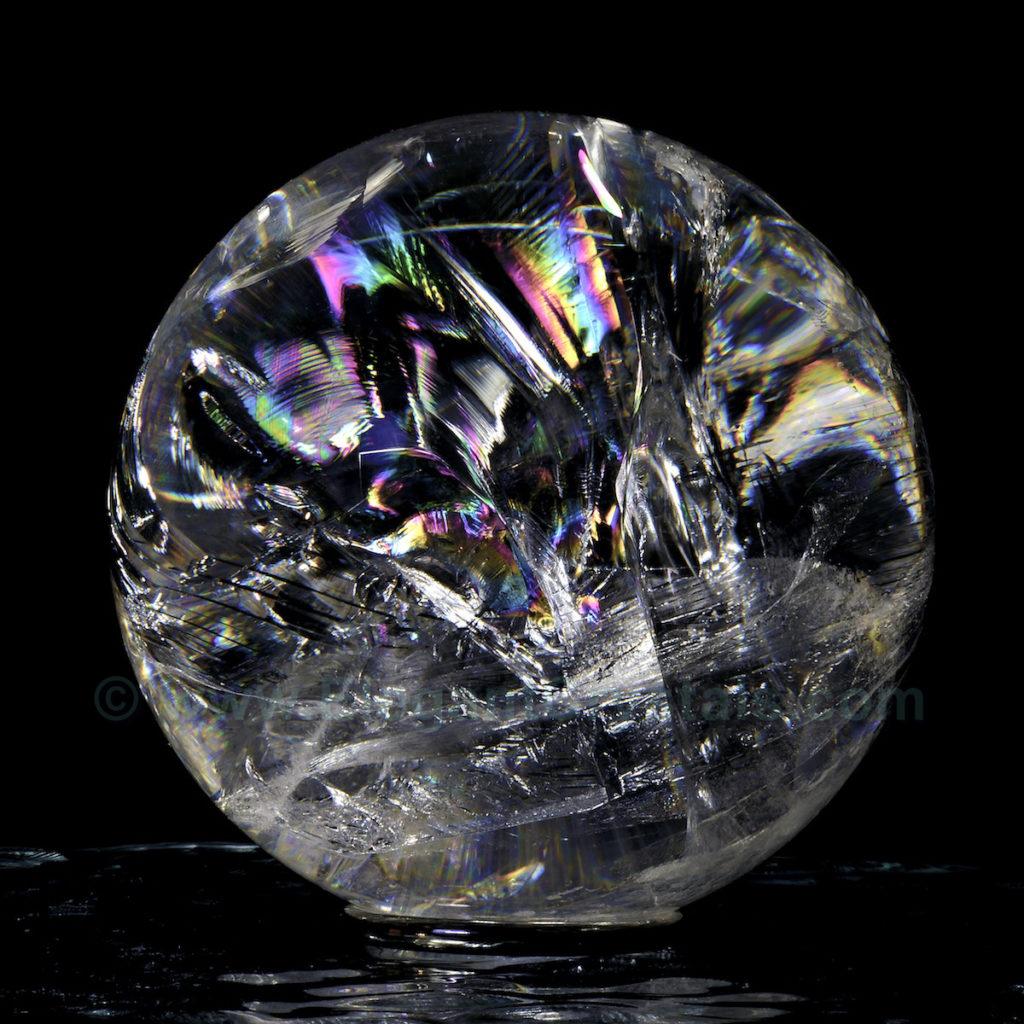
Picture #2
4-inch-wide Madagascar Quartz Ball
All rights reserved.
No part of this book may be used or reproduced by any means, graphic, electronic, or mechanical, including photocopying, recording, taping or by any information storage retrieval system without the written permission of ElegantCrystals.com, except in the case of brief quotations, less than 100 words, embodied in critical articles and reviews.
All images within this book are copyrighted by the author or specified photographers listed within.
Images cannot be copied or sold under fair use law.
Printed in the United States of America
Published by: The Elegant Crystals Partnership
Editors: Nancy Silverhawk and Tom Wagner
All Cover Designs by Adam Balesteri Graphics
adambalesterigraphicdesign.com
Note to Contributors
Dozens of wonderful miners, collectors and dealers have contributed crystals for the photography in this book series.
If you see your crystal pictured, without a credit, please contact me so I can add your name, mineral description and contact information to the crystal.
Email [email protected]
Please enjoy my FREE E-book called Crystal Treasure Trove
at my websites ElegantCrystals.com and CrystalBook.shop
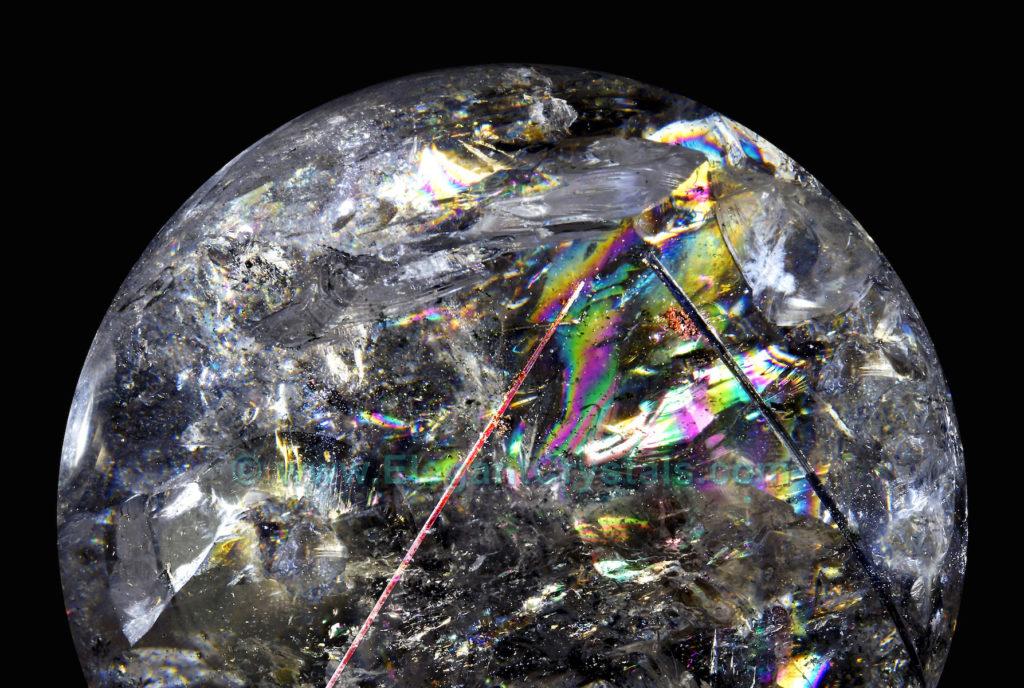
Picture #3
6-inch-wide Madagascar Quartz Ball
With Black & Red Rutile
PREFACE TO RAINBOW BEAUTY
Quartz crystals grow in an amazing variety of shapes and colors.
They are found all over the world, especially in America, Madagascar and Brazil.
Brazil has the largest accessible deposits of quartz, as well as the widest range of shapes, sizes and colors.
My favorite shapes mimic the architecture of buildings and skylines.
These all natural “crystal castles” and “crystal cities” are millions of years old!
I saw my first quartz castles and cathedrals in 1980.
Since then, I have looked at millions of crystals from all over the world to find little architectural marvels for my photos and videos.
I have documented these tiny “buildings” in every color and size, from 1 inch up to 8 feet tall.
I’ll put the “building stones” into context by sharing photos of other related crystals of various shapes and colors.
Quartz, along with some 4,000 earth-born minerals, creates an astounding range of geometries and glistening beauty.

Picture #4
Brazilian Kaleidoscopic Rainbow Quartz
If you begin a quest for the mineral gems of the Earth, please look into these many sources for stone treasures:
Antique Stores Bead Shows Cavern Gift Shops
Craft Shows Crystal Mines Design Galleries
Flea Markets Gem And Jewelry Shows Geology Supply
Gift Shops Internet Search Jewelry Stores
Lapidary Supply Metaphysical Shop
Mineral & Gem Shows Museum Shops
Natural History Museums Nature Stores Rock Shops
Science Centers Toy Stores
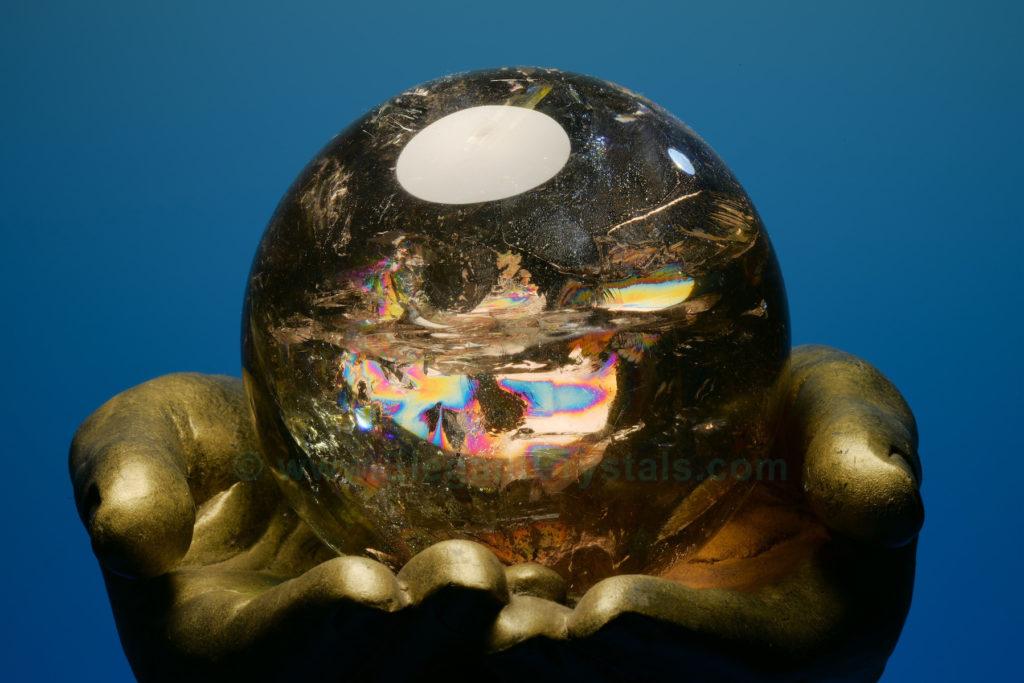
Picture #5
Brazilian Citrine Sphere
To learn more about collecting quartz crystals, please refer to my other volumes on crystals.
CRYSTAL TREASURE TROVE
INSIDE THE CRYSTAL CAVES
MAGICAL CRYSTAL TREASURES
AMAZING ROCK CRYSTALS
QUARTZ CRYSTAL CASTLES
ELEGANT CRYSTAL CITIES
RAINBOW BEAUTY
QUARTZ RAINBOW CRYSTALS
RAINBOWS FOREVER
And my five movies
RAINBOW SECRETS OF THE CRYSTALS
DANCING RAINBOW CRYSTALS
CRYSTAL MIRACLES
CRYSTAL MYSTERIES
BUBBLES OF JOY
Available at CrystalBook.shop
Or contact [email protected]
What do you look for when you are getting a new crystal or gem?
Excitement, adventure, energy thrills, variety, size, colors, clarity, inspiration or mysteries?
I love them all.
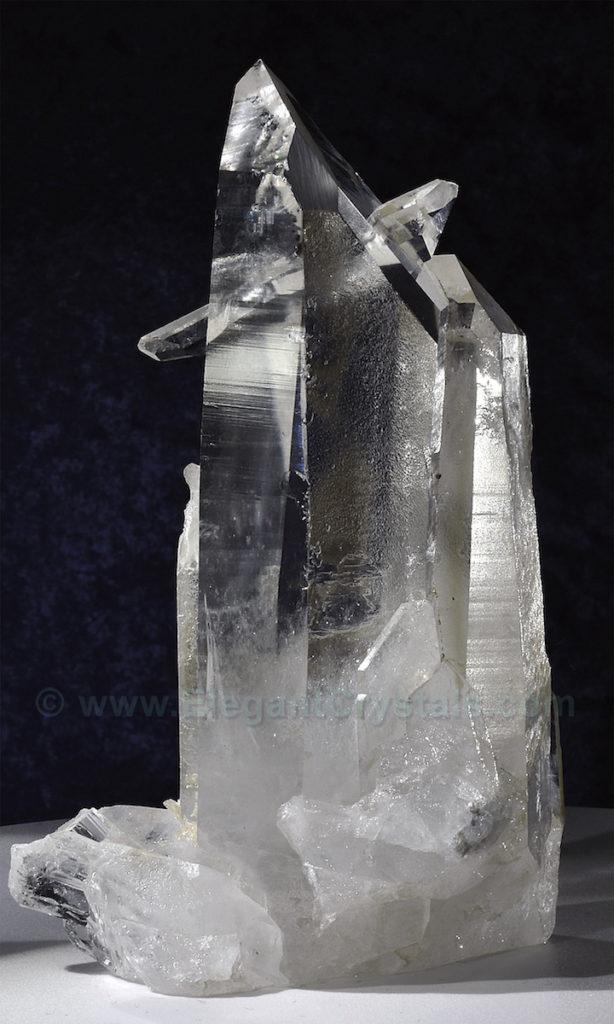
Picture #6
Cupid’s Crystal Arrow
Brazilian Double-ended Penetrator Quartz
My books are crystal love stories, visual records of my passion for the beautiful crystals emerging from under the ground.
If you are looking for a detailed scientific treatise on geology, optics or crystallography, this is not that book.
Please consider these three wonderful publications as starting points for a scientific course in Optical Rainbows:
Color and Light in Nature, by Lynch & Livingston
Rainbows, Halos and Glories, by Robert Greenler
The Color of Nature, by Murphy & Doherty
My interactions with rainbows and crystals are much too personal and emotional for scientific analysis.
I want to share a million little miraculous stones with you!
So far, I have included over 1,200 crystals in my nine books.
Each rock has a story for you.
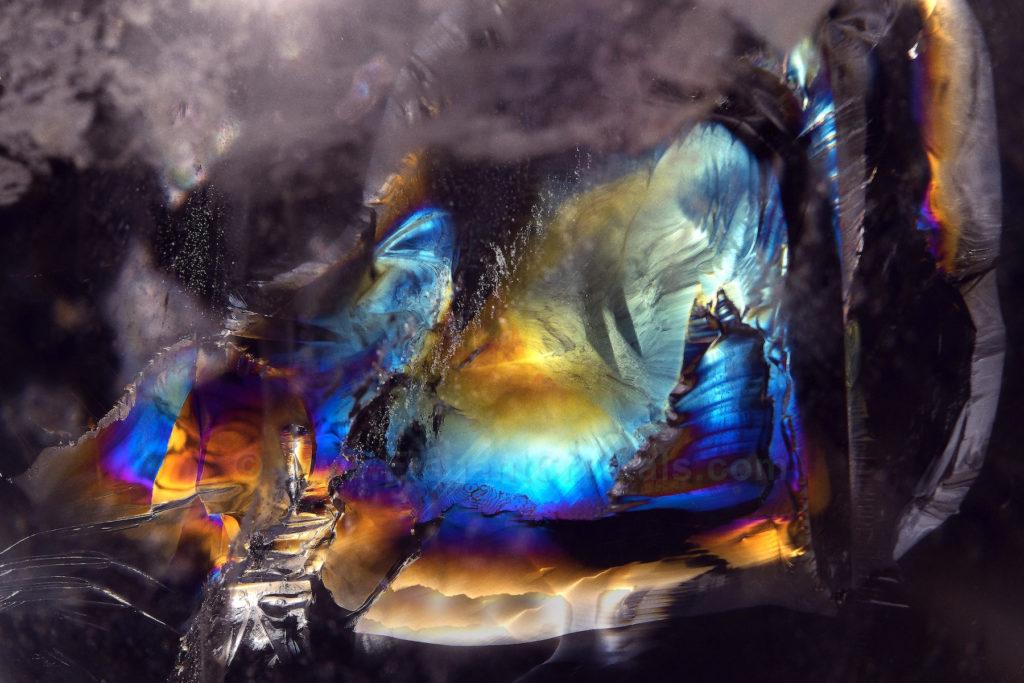
Picture #7
Iris Effect in Brazilian Quartz
I have blended my extensive crystal photography with evocative poetry in the rainbow volumes, plus hundreds of suggestions for working with quartz crystals and rainbows on many levels.
There’s lots of text to engage your mind if you are so inclined.
Or enjoy the poetry, culled from the best rainbow and crystal poems of the last 200 years.
When you read Cikira’s poems, please remember, she offers instructions for timeless power rituals using crystal balls.
The wise reader will look through the words to the profound experiences available.
Cikira’s energy rituals blend nicely with special meditations from Crystal Bill, i.e., me.
I recommend using the glorious photos to develop your innate ability to internalize colors, shapes and spiraling wave patterns.

Picture #8
2-inch-wide Madagascar Quartz Globe with Striations
Each picture can be a rich rainbow meditation; a daily inspiration.
A Rainbow a Day, makes the Shadows go away.
These volumes are a mixture of art, science, speculation, mystery and a little magic.
My prior books can give you a lot of background material for working with power stones, gems and crystals in many other ways.
You can access these books online at CrystalBook.shop
I hope your personal path includes curiosity for the many ways that stones and rainbows can take you through the Portals of Spirit.
I would like to share with you the sense of pleasure, inspiration and adoration that I feel when I see a good rainbow or a great crystal.
The first few chapters have a little more science than most.
Then we will move on to pure beauty and art, with comprehensive descriptions.
Here’s the summary: plants and animals use many kinds of cells and chemicals to build sophisticated crystalline structures that generate shimmering rainbows of light.
Mineral iridescence is the next topic, followed by quartz iridescence, in all the remaining chapters.
That’s where my greatest interest resides.
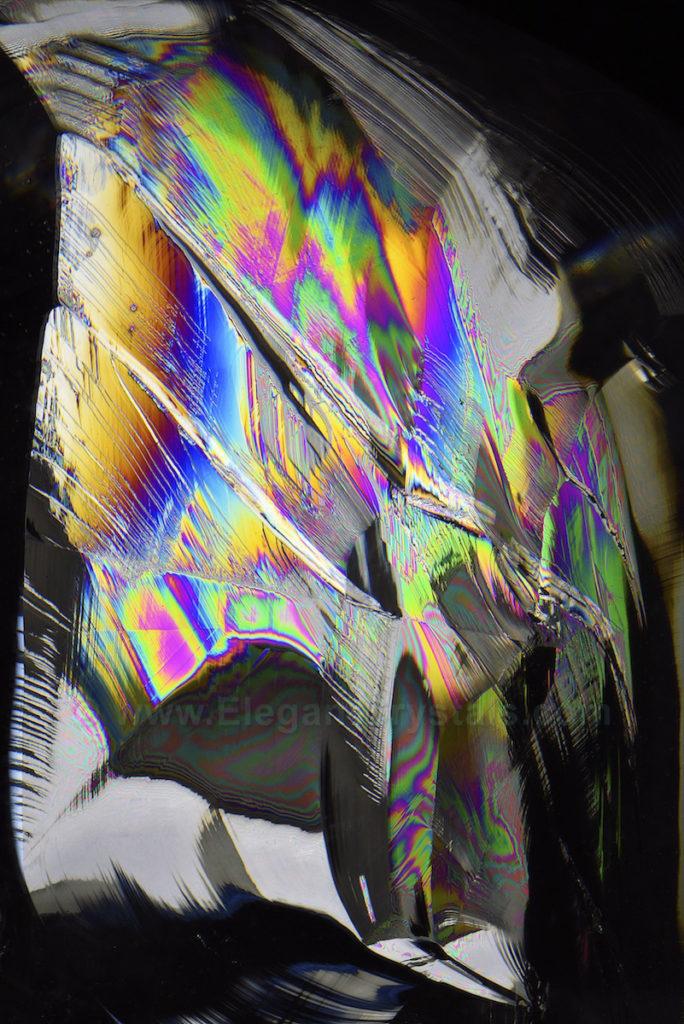
Picture #9
Iris Rainbow Fissures in Brazilian Quartz
CHAPTER 1
NATURE’S RAINBOWS
There is an enormous variety of colorful displays in the sky every day.
Somewhere on earth, rainbows are shimmering and glowing.
How many rainbows shine forth on our planet?
Dozens, hundreds, millions?
Can you picture that?
The whole planet is glowing.
Likewise, the rocks and crystals from the earth twinkle with myriad colors and flashes of light.
This book will showcase some amazing sky rainbows as an introduction to “refraction colors.”
Then we will transition through animal and plant rainbows to the many palettes of colors in rocks, and specifically, in quartz crystals.
We will see how colors and crystal patterns are dependent on the observer, as well as the materials and lighting creating the colors.
It has been said that no two persons see the same rainbow in the sky.
This happens because people’s eyes are different, their height is different, and while their positions can be close together, they will never share the exact same point of view.
Crystal rainbows in particular show huge variations in color when the crystal is moved by a millionth of an inch.
There is no shortage of sensational rainbows in our world.
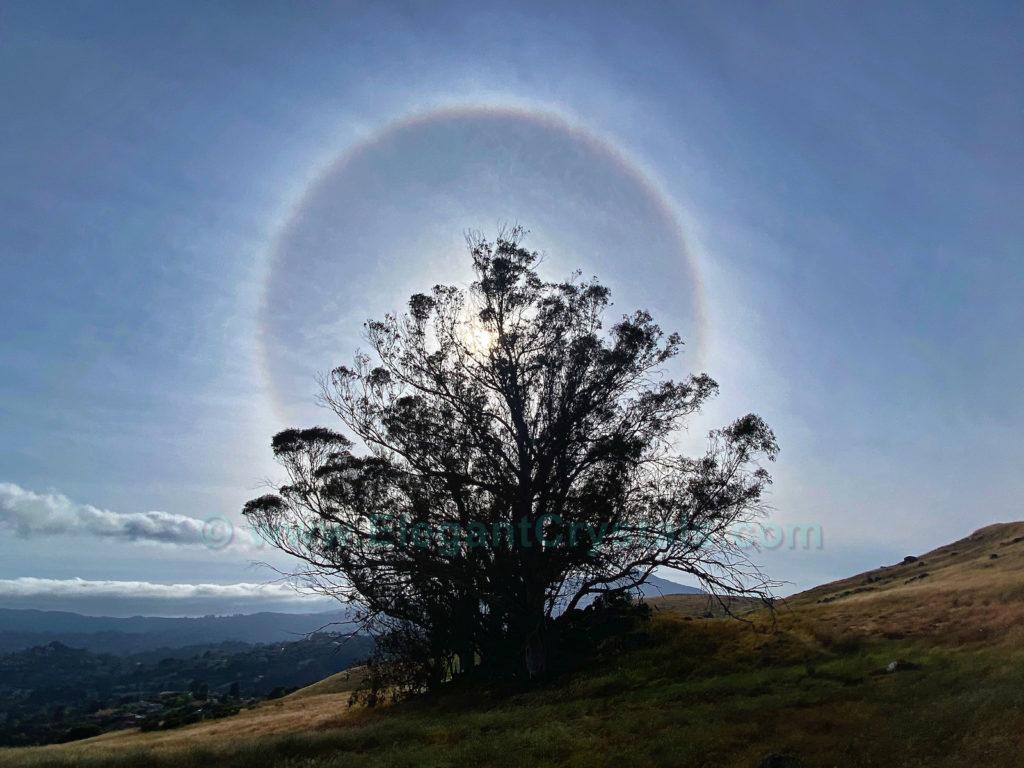
Picture #10
“Halo” at Tiburon, California, with Mt. Tamalpais in the Background
Photo by Caesar Ruegg
How often do you get to see the sun, along with a rainbow in the sky in front of you?
My favorite sky photographer, and friend, the Great Caesar, always captures the most amazing rainbows and vistas.
He specializes in rare aerial phenomena, and has a great viewpoint at almost 7-feet-tall!

Picture #11
“Halo” at Tiburon, California
with Mt. Tamalpais in the Background
Photo by Caesar Ruegg
When is a rainbow not a rainbow?
The word “rainbow” usually refers to an arc of colored light rising from the horizon.
A complete arc is called a “bow” since it resembles the shape of an archer’s bow.
Because of the association with hunting and warfare, bows in the sky often frightened people in ancient societies.
Nowadays, bright rainbows are seen as more inspiring and hopeful, rather than as forecasters of doom or warfare.
Either way, a rainbow can be a startling and riveting sight.
However, no rainbow is actually shaped like a bow!
Every rainbow is part of a circle of light, where at least half of the circle is below the horizon.
We just can’t see the totality of the circle from our low point of view.
Occasionally, people can see the total circular display from an airplane, mountain top or skyscraper.
These aerial light displays can also be almost color-free, as in the picture above.
Why is this image circular, and bright white, with only a hint of red coming through?
The light of the sun is reflecting off ice crystals miles-high in the atmosphere.
There is no rain involved.
The color is the same as white sunlight.
It is ever-so-slightly refracted by the ice, yielding a faint reddish tinge.
Unlike a colorful sky rainbow, the sun is in front of the camera, so the entire circle can be seen easily.
When the sun is behind you, early in the morning or late in the day, it creates the vivid reflected colors and partial-bow shape that we are used to.
Circular white displays are called “halos.”
The directional interaction of sunlight with the shapes of ice crystals or raindrops determines the intensity and colors of the display.
Likewise, we will see that the relationship of angles, internal mirrors and light can create wildly colorful displays inside quartz crystals.
A particular area in a crystal can look intensely colorful,
or shimmery white
or completely transparent
as our viewpoint changes.
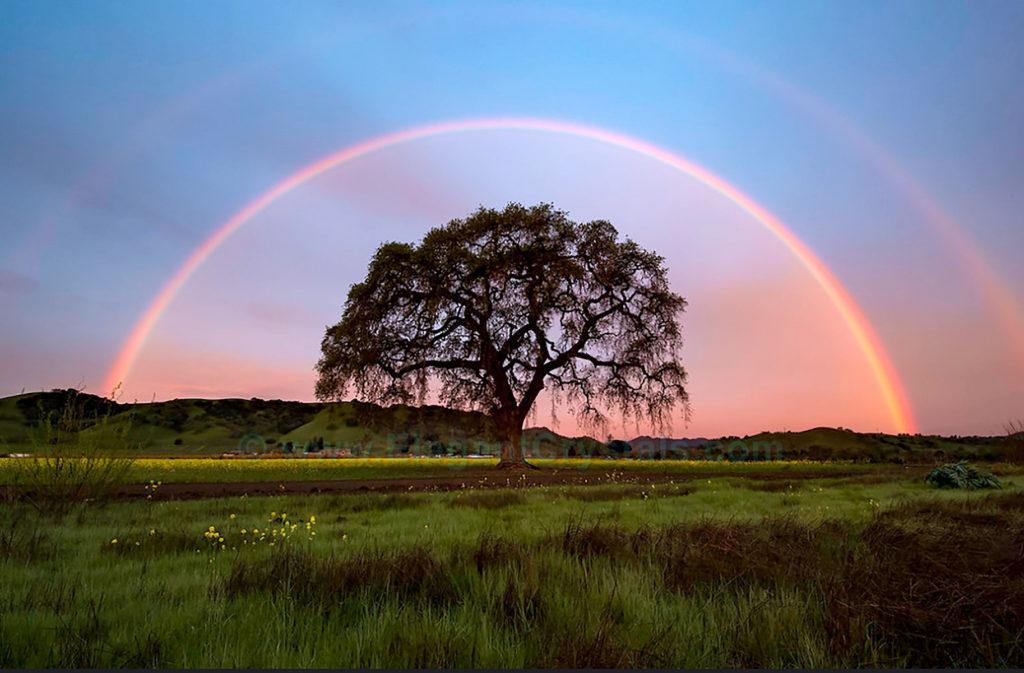
Picture #12
Morgan Hill California Double Rainbow at Dusk
Photo by John Fox@Omnitrigger
John Fox is my other favorite landscape photographer.
His life is dedicated to capturing the fleeting beauty of the sky, the land and the stars.
Check out his 1,000 favorite pictures John Fox@Omnitrigger on the Internet.
As this photographer explored the meadows near his home, he framed his favorite tree under a perfect double rainbow for a very dramatic effect.
The interior of the primary rainbow glows with lavender and rosy light that was reflected inwards by the red and yellow bow.
The secondary rainbow looks ethereal and ghostly to me.
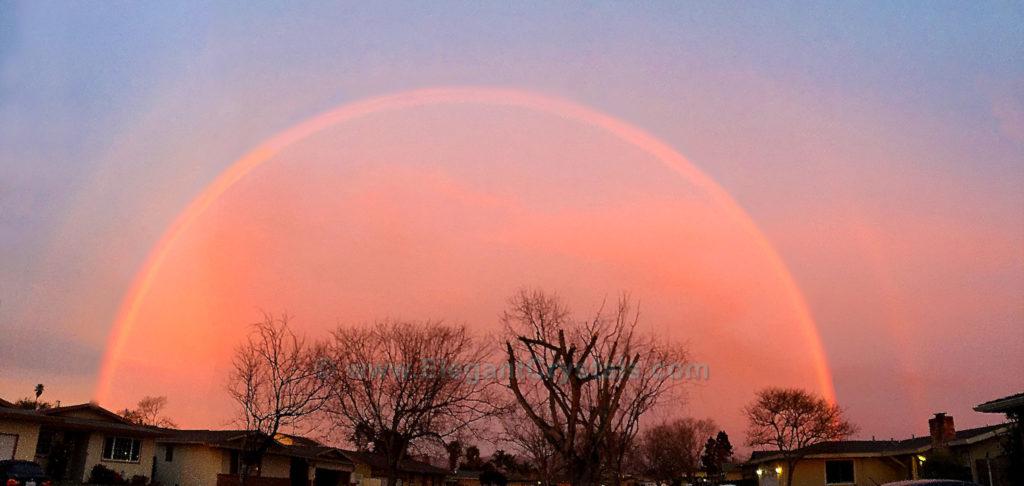
Picture #13
Salinas, California Rosy Double Rainbow
When was the last time you saw a rainbow glow in the sky?
Do you remember?
How did you feel?
Great rainbow displays are memorable moments in my life.
I connect with Heaven and Earth; with mist and sunbeams, with spirit and flesh.
I always pause to soak it in, to imagine myself surrounded with the iridescent shapes of shifting light.
How many rainbows do you think you have seen in your life?
I’m 70 years old now (in 2021), and guess I have seen 6 a year on the average.
Some months I might see two; or I’ll go for six months without a colorful sky display.
Perhaps there were a couple of hundred rainbows in my life so far.
They still live in my memories, somewhere.
I crave rainbow stimulation.
It makes my body feel good.
My emotions swing upwards, and my mind marvels.
I remember ogling dozens of rainbows from a crystal chandelier, some 60 years ago.
I always try to carry a lightweight camera for surprising, enchanting late-afternoon surprises.
Sometimes I don’t have to go far- the picture above was taken from my front doorstep after my wife, Nancy, shouted out a rainbow alert.
To capture a rainbow picture, work fast!
Sometimes the display only lasts a few seconds; other times there are several minutes of glorious light.
Meanwhile, the colors and intensity are constantly changing.
I often visualize my body becoming one with the rainbow as I picture the rainbow colors spinning within me.
This pink double rainbow is the fourth pink rainbow moment that I have seen in my life.
The sun is very low in the sky, just moments from sinking out of sight.
This pink arch, and the other pink ones, occurred in the flatlands of Salinas, California.
Heavy dust in the skies on the horizon creates the filtering effect that removes the other colors.
What is left is reddish pink, a little orange and yellow.
Can you see the faint second arc?
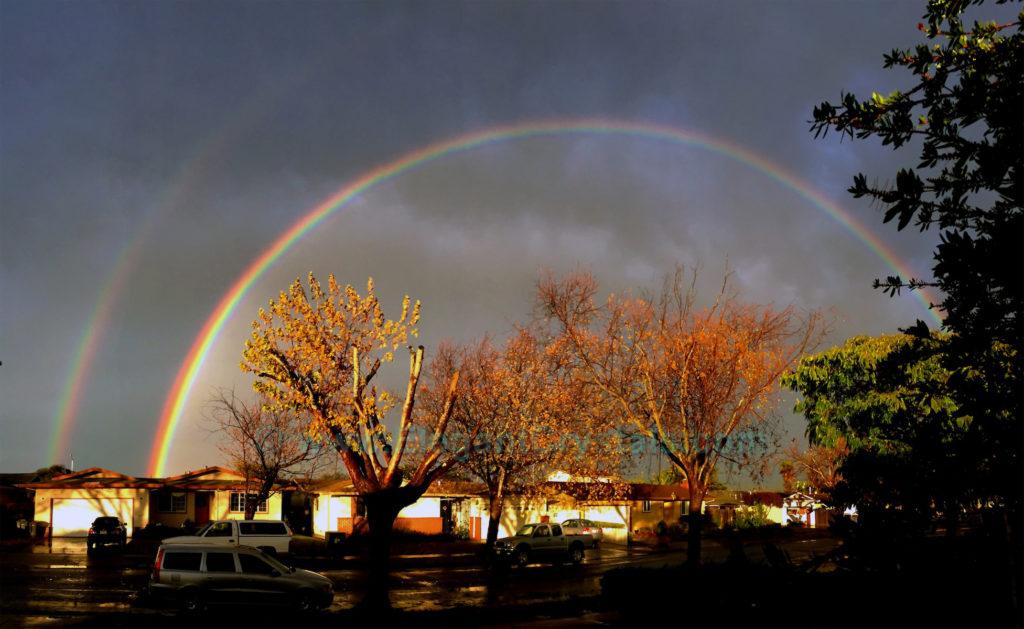
Picture #14
Salinas, California Double Rainbow
On a different day in Salinas, Nancy called out another rainbow alert from the front porch.
I heard the excitement in her voice!
This time, the I-phone’s panorama picture came out just perfect.
The conditions were ideal- the sun is low, and the clouds in the back are dark.
Check out the high contrast between the colors and the grey sky.
The inside of the bow is very bright, where the water drops focus all the colors as white light.
This is a glowing white hoop of wet air, directly under the rainbow.
A sky rainbow is never very thick, front to back.
In fact, it really doesn’t have any thickness beyond the tiny size of the water droplets.
Likewise, the rainbow effects inside quartz crystals are created by a layer of air, liquid or vacuum inside the quartz that is thinner than 1/1000 of an inch.
This “thin-film effect” creates shimmering colors in the sky; in vivid plants and animals, and in crystalline rocks.
Notice how the colors in the secondary bow are reversed from the first.
This secondary arch is due to double reflections in the water droplets.
The primary bow has only ONE reflection off the back wall of the water droplets, which acts as a mirror that bounces and spreads the sunlight.
The light bends (refracts) two times on its journey- once while entering the water drop, and once while exiting to the air.
This bending spreads the white light out into rainbow colors.
So, the primary rainbow’s color effect is a three-stage process-
bend, bounce and bend again
(refraction, reflection, refraction.)
The secondary arc is amazing:
Bend, bounce, bounce, bounce and bend.
The primary and secondary arcs seen together, are known as a multiple rainbow, with the characteristic white disc in the middle.
The dark zone between the colored arches is called the Alexander of Aphrodisias band, since it was first described, about the year 200 C.E.
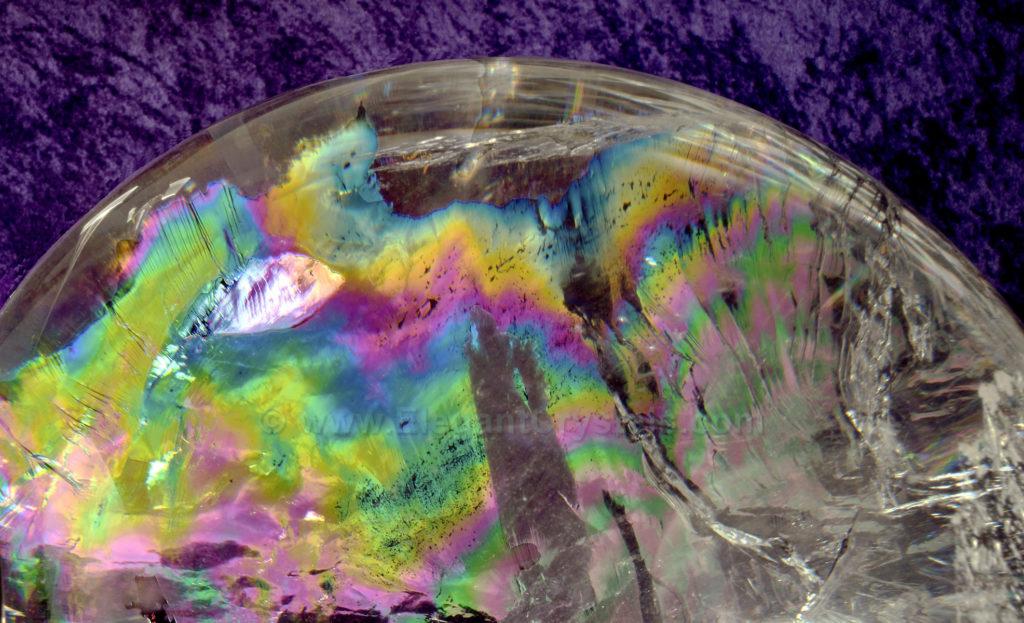
Picture #15
22-pound Quartz Crystal Ball with Iris Rainbow
I never realized I was “rainbow-deprived” before I started collecting crystals.
I always enjoyed seeing sky rainbows, but they were infrequent and unpredictable.
Never-the-less, for years, I would keep an eye on the weather to try to predict rainbow days.
Then the world of rainbows opened up for me, when I found that clear crystals from Brazil, Arkansas and Madagascar had sparkly, vividly colored rainbows inside.
The clear natural columns of faceted quartz crystals also acted as prisms that bent sunlight into colors.
So, the “included” crystals had rainbow “foil” inside, while the clearest ones projected beautiful colors into the shadows of a room.
The inner rainbows are often called “iris rainbows.”
Historically, Iris was the name of the Rainbow Goddess of the Skies.
She is often associated with the Messenger God, Mercury.
The word “iris” evolved into “iridescent,” meaning any shimmering display of changeable colors.
The big crystal ball pictured here, at 8-inches-wide, has a sheet of color going all the way through it.
Vivid tones and fascinating rippling shapes led me to take a thousand photos of this complicated, yet small landscape.
You’ll see a whole chapter on this ball later, under its self-appointed name- “The Oh My God Ball.”
This crystal ball named itself on the day it arrived in the mail.
When Nancy and I opened the box, a ray of warm sunlight lit up the amazing colors on the iris-foil inclusions inside the globe.
For several minutes, we stood around gasping and uttering “Oh My God, Oh My God, On My God.”
I had never seen such a lovely, colorful display in my 35 years of collecting.
For the next few weeks, I would wander into the kitchen at dawn, and keep repeating its obvious name- Oh My God!
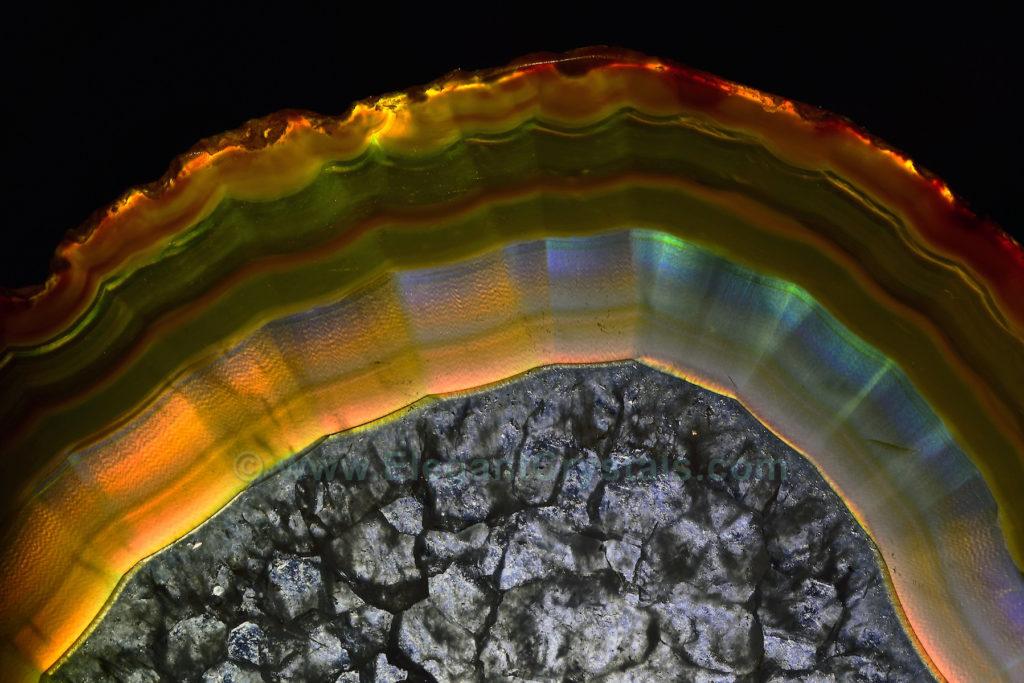
Picture #16
3-inch-wide Slice of Polished Brazilian Agate; 1/8”-thick
The atomic composition of rocks determines their colors.
Silica (quartz) mixed with metals generates the colors of ordinary opaque rocks, which don’t tend to change much, even over millions of years.
Clear crystals, on the other hand, have infinitely variable color displays that fluctuate as you move them around or change the lighting.
The slightest movement of the crystal, the light bulb or the camera will yield vastly different colors and patterns.
To stabilize the process of recording images, I have to:
place the crystal on a sturdy stand on a stable table;
use a heavy-duty tripod that doesn’t wobble, even under the weight of a heavy camera and lens;
use lamps and bulbs that hold their position, without moving a fraction of an inch.
Ideally, this kind of precision photography is done on a concrete floor.
In reality, my studio always seems to be in a room with creaking wooden floors.
I have to be careful not to move around or shift my weight during the filming.
Sometimes I move into another room, and trigger the camera with a remote-control release button.
The slightest movement in the floor can shift the focus and the colors.
I use a large-screen TV monitor, running off the camera, to preview these shots.
It’s easy to see vibrations and wiggles on the big television set.
Occasionally, I can feel my heartbeat vibrating through my body, into the floor, and then showing up on the giant TV screen.
This iris agate is a special variety of quartz crystal found in Brazil.
When it is sliced and polished to the correct thickness, amazing colored bands appear around the outside of the stone.
The inside is pure colorless quartz crystals fused together into a type of high-quality glass.
The color display changes with any variation in the light.
Full rainbow colors are best seen when the light is 15 feet behind the stone.
As the light bulb gets closer to the agate, individual colors predominate, then shift from moment to moment.
If you look closely at the orange area, you can see rippling patterns in the crystal that mimic the atomic patterns inside the stone.
The agate is acting like a diffraction grating- we will examine diffraction in a later chapter.
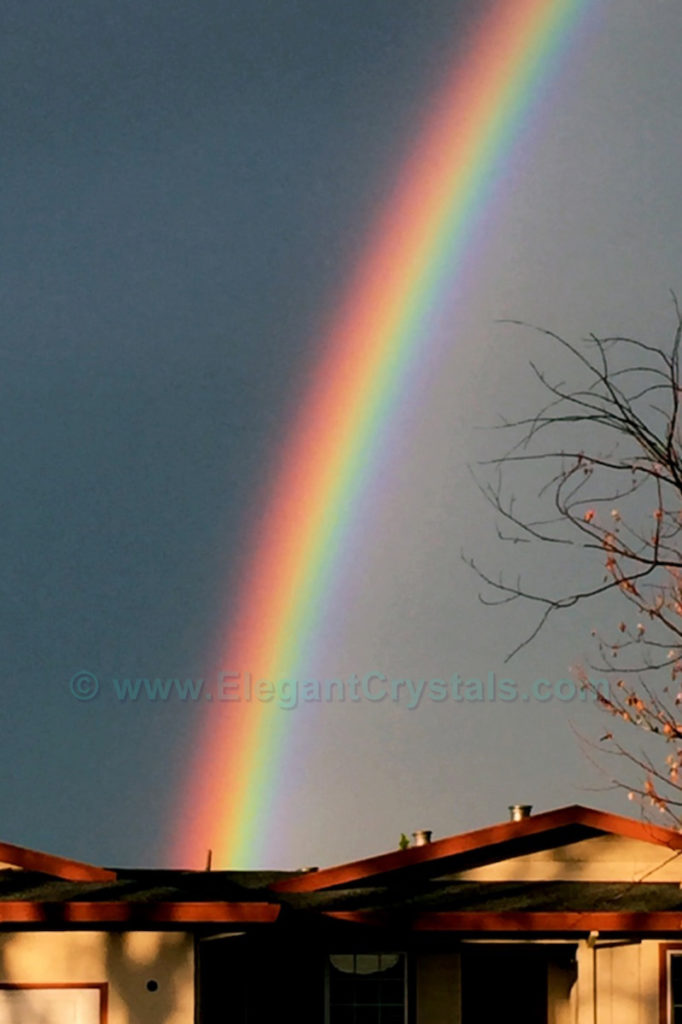
Picture #17
Salinas, California Rainbow
My front porch in Salinas is a great platform for sky viewing.
Sunsets are always dramatic here.
The arc in this picture is a close-up view of the double rainbow we saw earlier.
This vivid picture does not do justice to the intensity of the rainbow that day.
The dark clouds in the background create wonderful contrast with the colors.
Note the lighter area inside the colors.
Why is it so much brighter than the rest of the sky?
When circular raindrops break up light, they throw the colors all the way across the rainbow in great discs of individual hues.
Where all the color discs are stacked one upon the other, in the center, the result is a blur of white light.
Each colored circle is a slightly different size, allowing us to see the individual colors at different distances, on the edges of the discs.
Since the purple band is closest to the bright white light, it tends to blur out, and not show very distinctly.

Picture #18
3-inch-long Detail inside a 42-pound
Brazilian Citrine Quartz Crystal
Many quartz crystals are absolutely clear, with no inclusions at all.
Completely clear crystal balls are sometimes cut and polished from this amazingly clear quartz.
These are considered rare treasures.
Typically, other types of quartz crystals have a variety of things (inclusions) inside them.
Inside the crystal, you can find:
Colors from atomically-distributed traces of metals
(amethyst-manganese, citrine-iron, smoky-aluminum and rose quartz-titanium)
Tiny gas and liquid bubbles;
Traces of clay or sand
Small metallic crystals and gems;
Cracks and fissures from heat or earthquakes
Air-filled, water-filled or vacuum gaps
Discontinuities in the atomic structure.
All these inclusions lend variety and interest to the art of crystal gazing.
Each type of inclusion practically demands its own book!
This book focuses on the quartz crystals with gaps, cracks, discontinuities, fractures and fissures inside the crystal.
The cracks create an area where water, air, other gases or liquids, even vacuum spaces, occur as layers between two sheets of quartz, one on either side of the gap.
There is a “thin film” of some material (or vacuum- no material), which could even be a layer of rust or metal, inside the quartz.
The layers of quartz act as both transparent glass and reflective mirrors, depending on the angle of the light.
As white light bounces around in the thin layers
(1/1000 of an inch to 1/30,000 of an inch,)
colors are created by refraction, reflection and diffraction.
The citrine crystal pictured here has seven huge rainbow areas inside it.
Even though the crystal is 15” tall and 10” thick, it is almost entirely clear.
All the rainbows can be easily seen and photographed from the front or the back.
We will see some more pictures of it later.
I call this crystal “Rainbows!!!!!!!”
I chose this image to show how the quartz rainbow shape can mimic the rainbow arcs in the skies.
The color patterns are similar to sky rainbows, but significantly different.
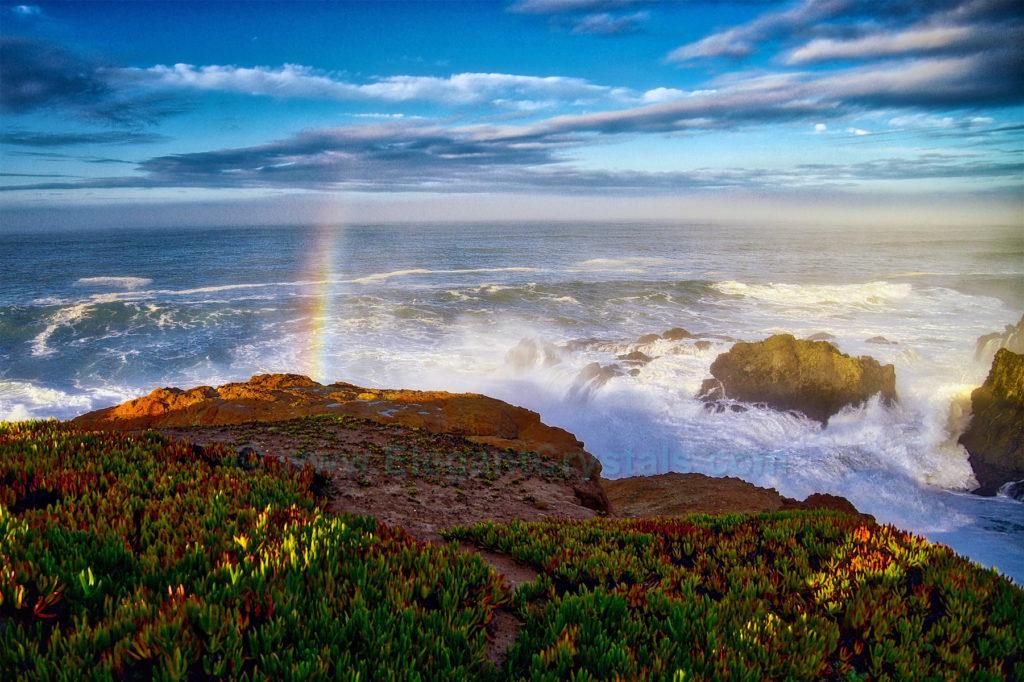
Picture #19
Bodega Bay California- Surf Rainbow
Photo by Caesar Ruegg
My friend Caesar (All Hail the Great Caesar!) always carries a camera with him.
He discovers great vantage points from his home by the Pacific Ocean, and in his high-rise office space in San Francisco.
He is always delighted to take a break from work when the rainbows appear.
With his 20-mile view from the office, Caesar is well situated to capture the unusual rainbows that form over San Francisco Bay.
He has seen, and recorded, more spectacular rainbows than anyone else I know.
Caesar also collects rainbow crystals, as I do, with great delight.
Rainbows in the sky, or in crystals, do not need to be huge to be impressive.
This tiny surf rainbow in the spray from the waves graces a dramatic vista of natural beauty.
To me, it is almost an exclamation point on the glory of nature.
You can create a similar rainbow in your back yard, when the sun is behind you, low in the sky.
Just spray mist in the air from a water hose.
Do-it-yourself rainbows!
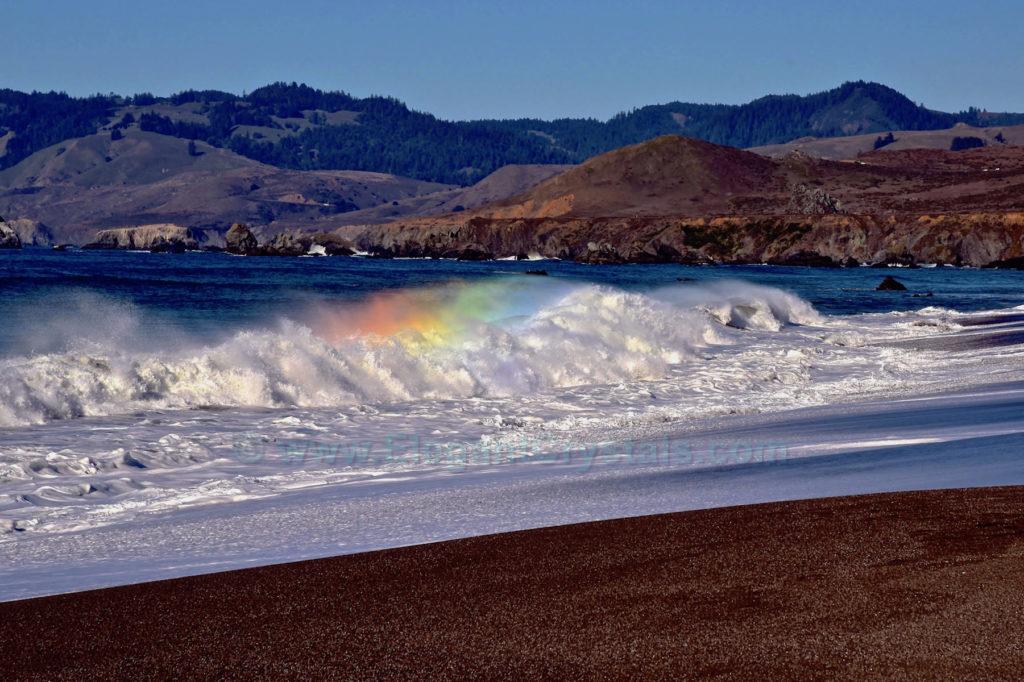
Picture #20
Surf Rainbow, Bodega Bay, California
Photo by Caesar Ruegg
On this bright, lucky day, Caesar captured a misty rainbow above the ocean’s wave.
He didn’t know the rainbow was there until he reviewed the pictures.
It only appeared in one shot.
This type of rainbow has been documented a few times in history.
It is a rare and subtle effect.
I did a search for surf rainbows on the internet, and found a couple of mediocre snapshots.
This is my favorite sky rainbow picture of all time.
I get to see it every day as the screensaver on my computer.
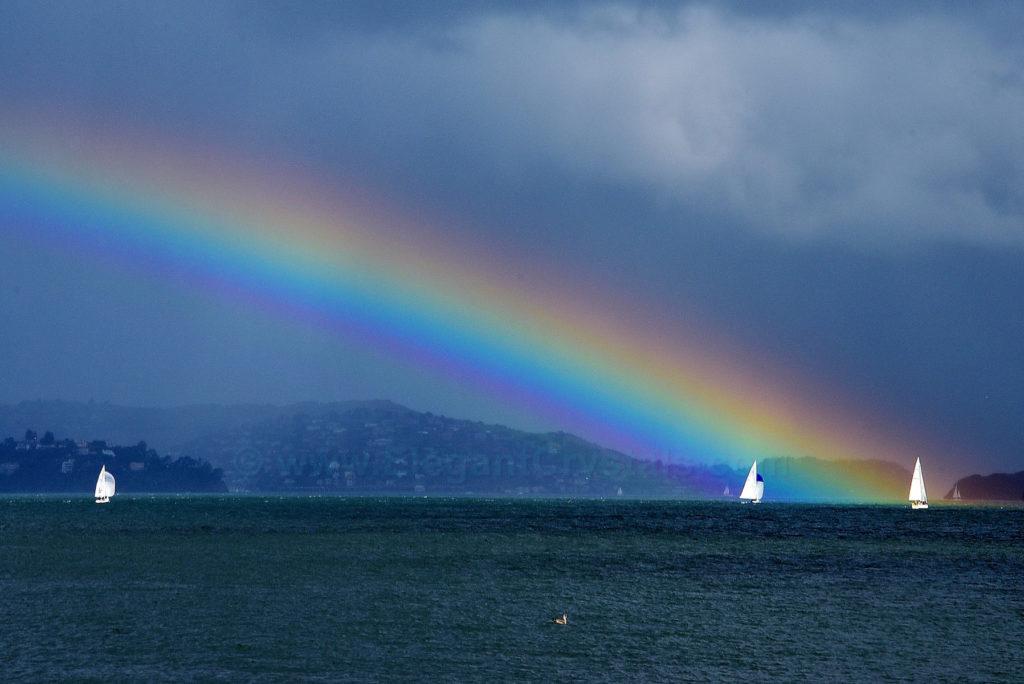
Picture #21
Late Afternoon Rainbow
Tiburon, California and the San Francisco Bay
Photo by Caesar Ruegg
This photo defines the word “vivid.”
And yet the glory of the image does not approach this divine arc’s beauty.
These colors are not “pumped” in Photoshop.
The original viewing over the water was completely dazzling.
Note the intense purple color Caesar captured with a big zoom lens.
This is rarely seen in the sky.
It showed up well with the dark gray clouds in the distance.
These lovely glowing bands make me want to reach out and grasp the delight of the colors.
Of course, there is nothing there to really touch, so I need to accomplish this by using my imagination and visualization.
I like to create these colors internally.
Then I send them out to parts of my body and aura to activate my endorphins.
If I could be a rainbow, this is what I would look like.
Check out the end of book 9, chapter 13, to see my personal rainbow vision.
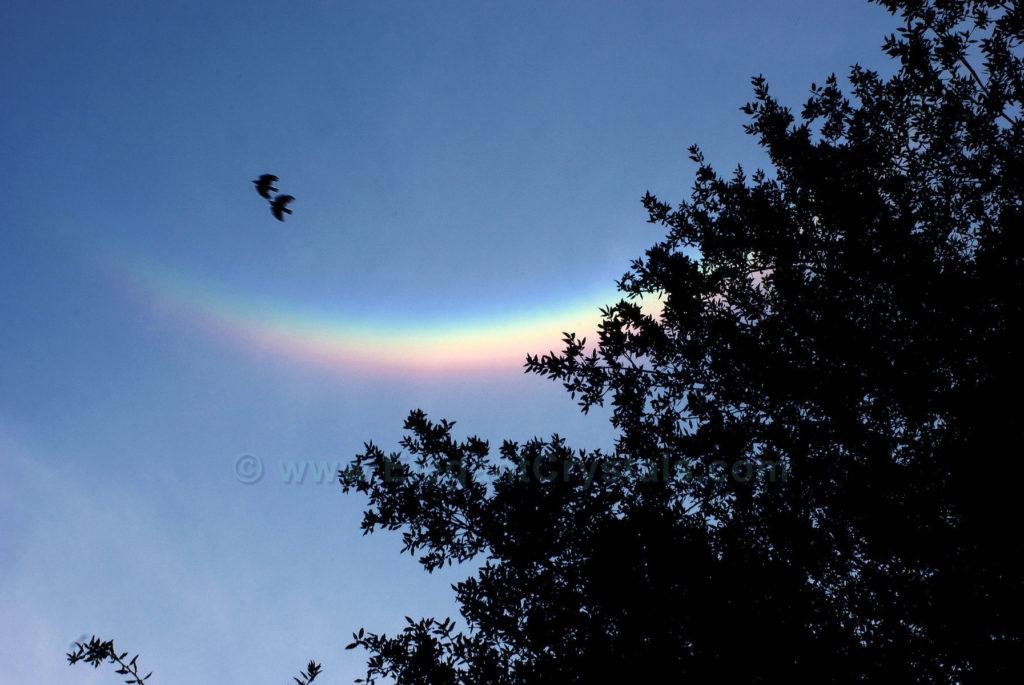
Picture #22
Circumzenithal Arc (CZA) over Walnut Creek, California
This fairly rare phenomenon occurred late in the afternoon on a fine summer’s day.
Note that the rainbow’s curve is facing the “wrong” direction, creating a great Cheshire Cat’s smile in the sky.
There is no rain in this bow.
It is created by high altitude ice crystals in the stratosphere.
The timely appearance of the birds was an added bonus that I discovered when I reviewed the photos.
Backstory
I had just completed a long, tiring weekend at the Walnut Creek Crystal Faire.
This two-day show is sponsored by the Pacific Crystal Guild.
Please call Jerry Thomlinson at 1-415-383-7837 to get on the mailing list.
That particular weekend, I set up a display of 1,000 pounds of fine crystals for sale.
After the show, we packed up quickly to get ready for the 2-hour drive home.
I was completely exhausted after all the lifting work, and mentally exhausted after talking to hundreds of people.
Once the van was packed and loaded, I decided to relax briefly, by lying down on a bench in the park.
I closed my eyes for a minute and did some deep breathing to recharge my energies.
When I opened my eyes, here was this amazing, resplendent display.
I had to jump up, run to the van, unlock the doors, dig out my camera, run back to the bench and lie down to take the picture.
The birds appeared, and CLICK it was done, and it WAS good.
I have seen 3 CZAs in my life. I was lucky enough to get pictures of two of them.
I remember each one vividly- when, where and how.
The one I didn’t get to photograph had bright fluorescent colors- absolutely unique.
I’m sorry I can’t show it to you.
Remember to bring a camera or phone camera with you at all times! I certainly do.
There is a wonderful website in Great Britain that specializes in images of rainbows and rare aerial sights.
To see their extensive photo collection, and greatly detailed descriptions of the optics, check out their heavenly visions at:
AtOptics.co.uk
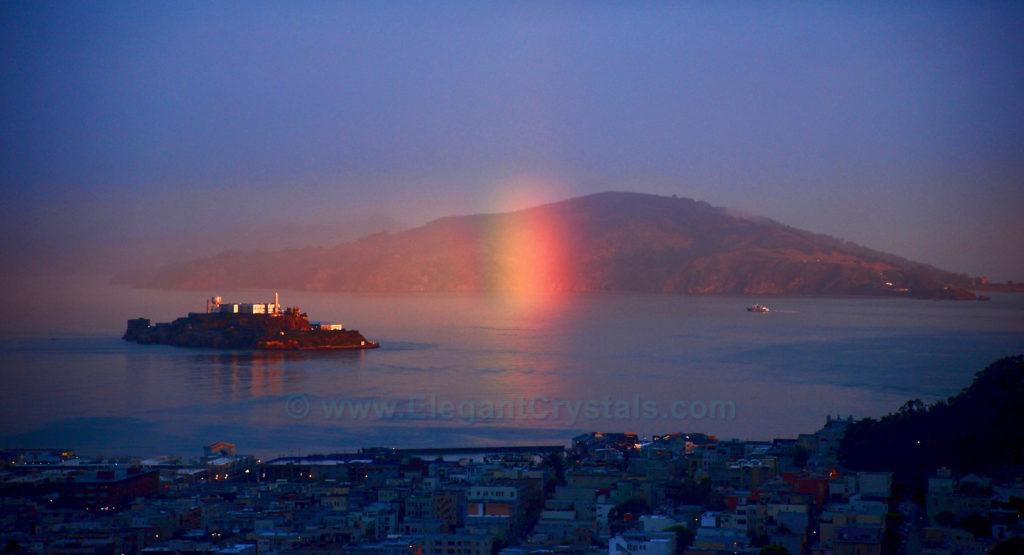
Picture #23
Rainbow Arc at Dawn over Angel Island &
Alcatraz Island; San Francisco Bay
Photo by Caesar Ruegg
This wonderful photo incorporates several unique rainbow features.
I was so impressed how the rays reflected as rainbow colors in the water.
Even though the Bay is always rippled by waves from strong tidal currents, the sea is acting like a giant smooth mirror.
The light fog in the air blurs the camera’s view of the waves ever so slightly.
Thus, the sea looks like it is slick and smooth.
The full seven colors are shimmering right above the water, yet all the colors are affected by pink light illuminating them.
It looks like a pinkish beam is coming in from the left side of the scene (west side).
Is it a huge sunny spotlight beam terminating in a rainbow?
No, that’s just an optical illusion.
The sun is not setting in the West.
The light and shadows on the buildings places the sun just south of east at dawn, in this northward-looking view.
Alcatraz Prison glows cheerfully in the warm-colored light.
The intensity of the light increases towards the red end of the rainbow, giving it a particular fiery look.
The purple part of the arc is now yellowish as well, with faint secondary colors over Angel island.
There is a faint extra rainbow inside the main arc.
This kind of display is called a supernumerary bow.
These unusual effects come from a very wispy layer of fog drifting under the Golden Gate Bridge.
The top of the fog seems about level with Angel Island (788-foot elevation.)
Above that, there is no fog or moisture in the air to capture the light- no rain falling and no rainbow at the top.
Would you call this a fog-bow? Mist-bow? Vapor bow? Haze bow?
Why is the air glowing over Alcatraz?
This slightly colored light is basically white, and represents part of the white disc of light found within particularly bright rainbows.
Dust and moisture in the air filter the dawn light into a pinkish-yellow dream beam.
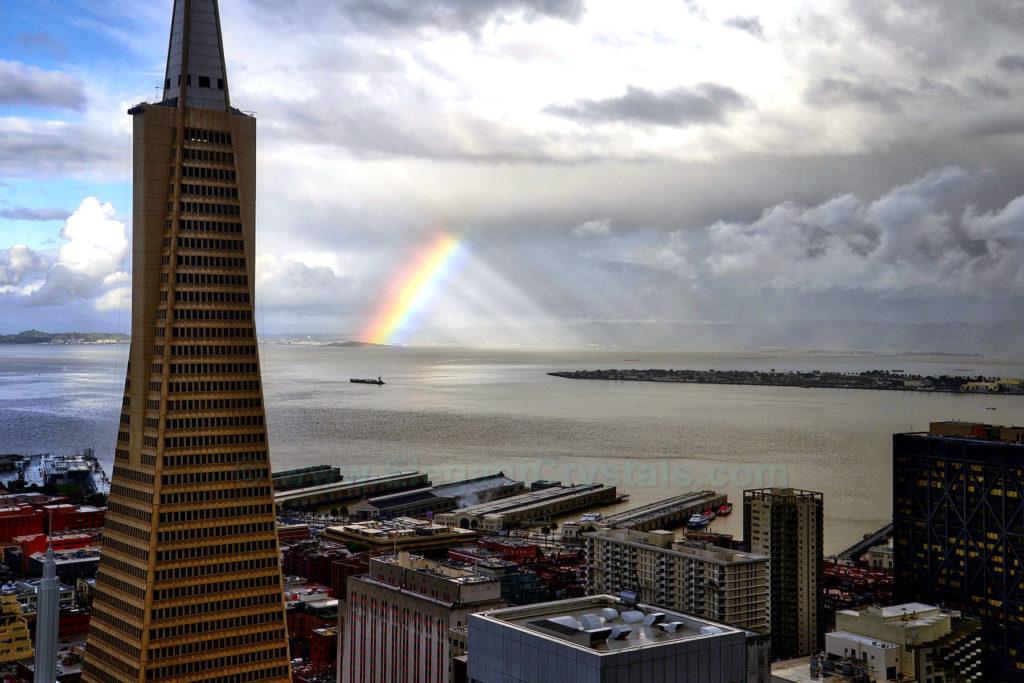
Picture #24
Rainbow Pyramid over the
San Francisco Trans-America Pyramid
Photo by Caesar Ruegg
I once saw a similar rainbow pyramid in person, on April 20, 2000 at 6:30 p.m.
Why is the date so memorable and specific?
It is the day my intuition told me to take my camera along, and I didn’t listen.
I missed getting a picture of the best sky rainbow of my life.
So far.
I never expected to see another rare, rainbow-sided sky pyramid.
When Caesar showed me this image, I was stunned by déjà-vu.
In his picture, the thick clouds clipped the rainbow arc at the top.
Rainbows only appear when small raindrops hover in clear air.
Heavy clouds totally block the color formation.
The white streaks are refracted rays bouncing off the central white disc, which is only partly formed here by the patchy fog and rain.
These faint angled rays spread all the way across the picture.
I felt extremely lucky to see this event twice in my life, even if one of them was someone else’s photo.
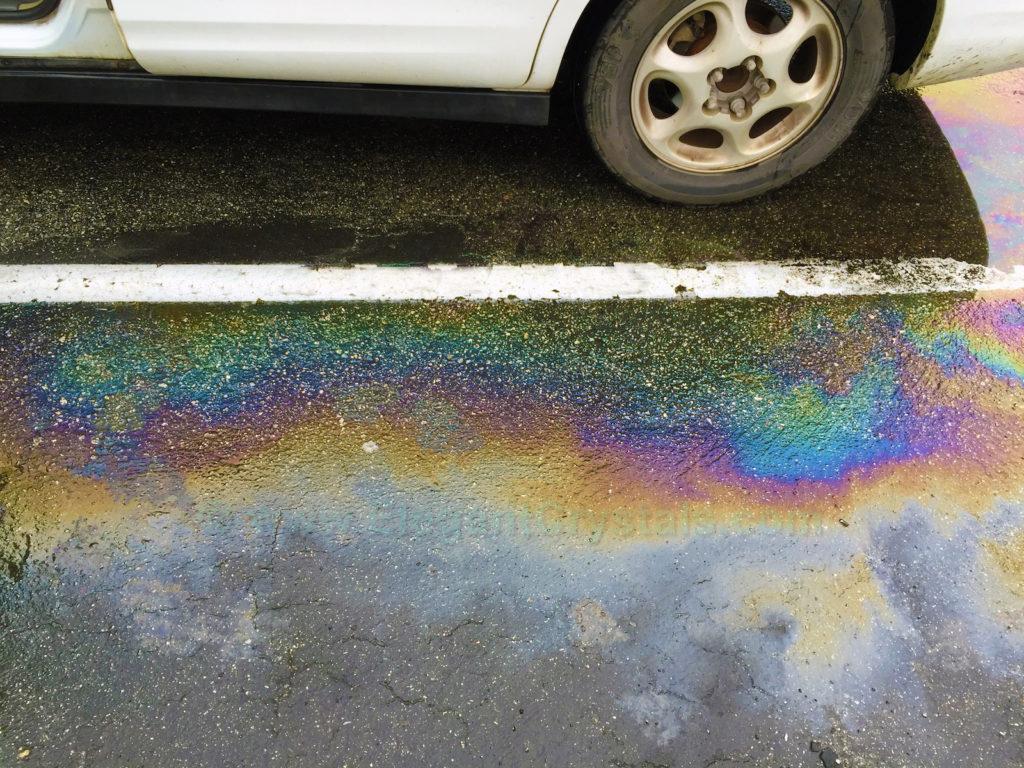
Picture #25
Oil-film Rainbow in our Parking Lot
Not all rainbows are gigantic glorious divine displays in the sky.
If you start looking for rainbows, you can find them anywhere.
Squint your eyes, and your eyelashes turn into rainbows.
Spiderwebs glow with brilliant colors in late afternoon sun rays.
Polarized plastics shimmer with sheets of color.
The hair on your arm changes colors and glows in a beam of sunlight.
These are all “thin film effects” which surround us every day.
As I stepped out of the car one day, a little oil spill caught my eye.
I like the sparkly pavement stars that make it look cosmic.
I felt like I was staring down into the Milky Way Galaxy.
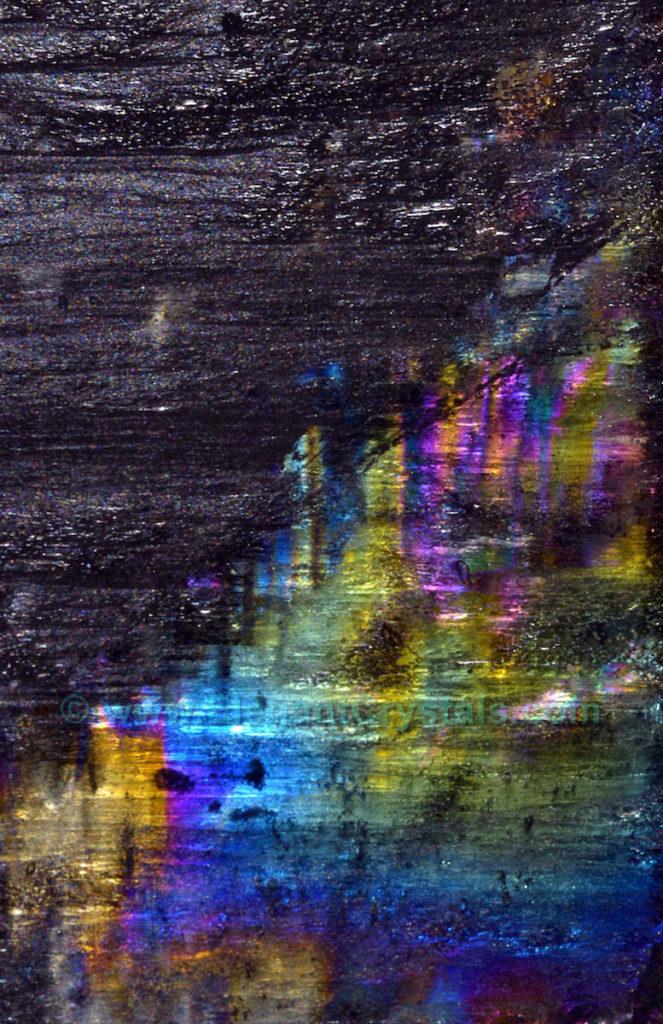
Picture #26
Iris Rainbow within a Striated Quartz Crystal
This crystal photo reminds me of the oil-on-water photo, but its origin is totally different.
We are looking at a clear quartz crystal in front of a dark background.
This makes the clear parts of the crystal look black, while it shows off the fine colors.
This image caught a brightly colored reflection off a crack about ¼-inch below the surface of the crystal, and parallel to the side of the crystal.
Since the surface of the crystal has growth lines called “striations,” these ripples break up the colors into lively patterns.
The darkest part of the image in the top half clearly shows the intricate surface patterning.
It reminded me of the pavement appearance in the oil rainbow image.
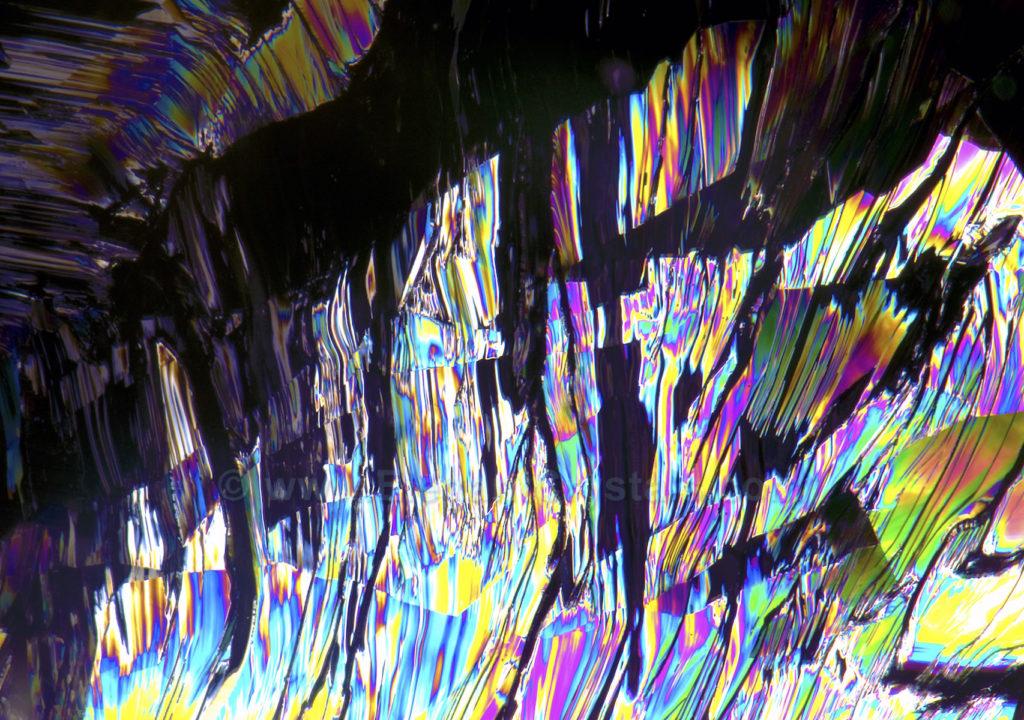
Picture #27
Rainbow Striations in a 10-inch-tall Citrine Quartz Crystal.
There are several types of striated rainbows in quartz.
Please take a look at Chapter 23 for a great selection of unusual photographs.
This particular crystal has four kinds of rainbow patterns inside, which merits its own chapter.
I call it the Citrine Temple, because I found images inside it, under high magnification, that looked like an ancient hillside temple.
The patterns here are repetitive shapes, waves and colors laid out in specific natural mathematical intervals called “fractals.”
The Citrine Temple has the most complex and interesting fractal waves that I have ever seen in a quartz crystal.
The general term “quartz” covers a lot of territory.
It can refer to any color of quartz, although the color is usually tacked on to the name to make it more clear which rock we are talking about.
Clear quartz
White quartz
Black quartz – morion/cairngorm
Golden quartz- citrine
Pink quartz- rose quartz
Smoky quartz
Purple quartz- amethyst
Ametrine quartz- purple and gold
Green, blue, orange quartz- aventurine
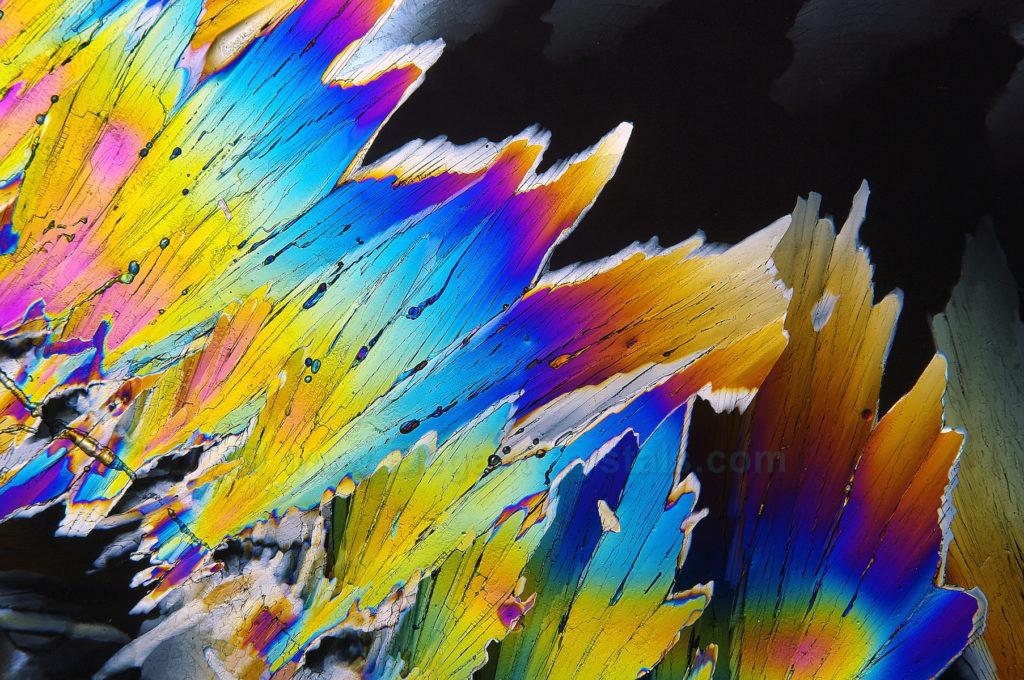
Picture #28
Jack-frost Ice Crystals under Polarized Light
Photo by Tom Wagner
And now for something entirely different.
“Iowa Tom” photographs ice in the winter in Iowa.
His studio shed is open to the weather, and is always below freezing cold.
His special camera equipment has to withstand rigorous temperatures.
He discovered that he could make thin colorless layers of ice turn into rainbow landscapes by using two polarizing filters; one on the light source behind the frost, and one filter on the camera.
This polarizing trick brings out dynamic spectra in the thin film of frozen water.
You can’t see the colors in ice without polarizing filters.
In contrast, within quartz crystals, the iris colors are clearly visible to the unaided eye.
In fact, they are dazzling and highly reflective mirrors that are unusually easy to see.
It takes a little patience, as the angles from your eye to the crystal to the light, must be just right.
We say that the color visibility is “highly angle dependent.”
The flip side of this concept is the appearance of shimmering, changing colors when the crystal moves even the tiniest bit while you hold it.
A moving crystal has colors that always change and look very lively.
If the viewing angle changes too much, the quartz colors disappear and look like silvery tin foil, or perhaps completely transparent.
I use a double polarizer filter on my camera, also called a circular polarizing filter.
One filter is immovable and the other spins around to control the degree of polarization.
With quartz, the polarizer clarifies the sharpness of the image as well as the purity of the colors.
The double polarizer removes a faint double image from the inside of the crystal that is created at the atomic level of the gemstone.
The filter also leaves pure spectral colors that would otherwise be blurred by nearby colors in the secondary image.
In the chapter on the Iris Effect, I’ll show you how to use double polarization to distinguish a quartz crystal ball from a glass crystal ball.
It is a handy technique that could save you a lot of money.
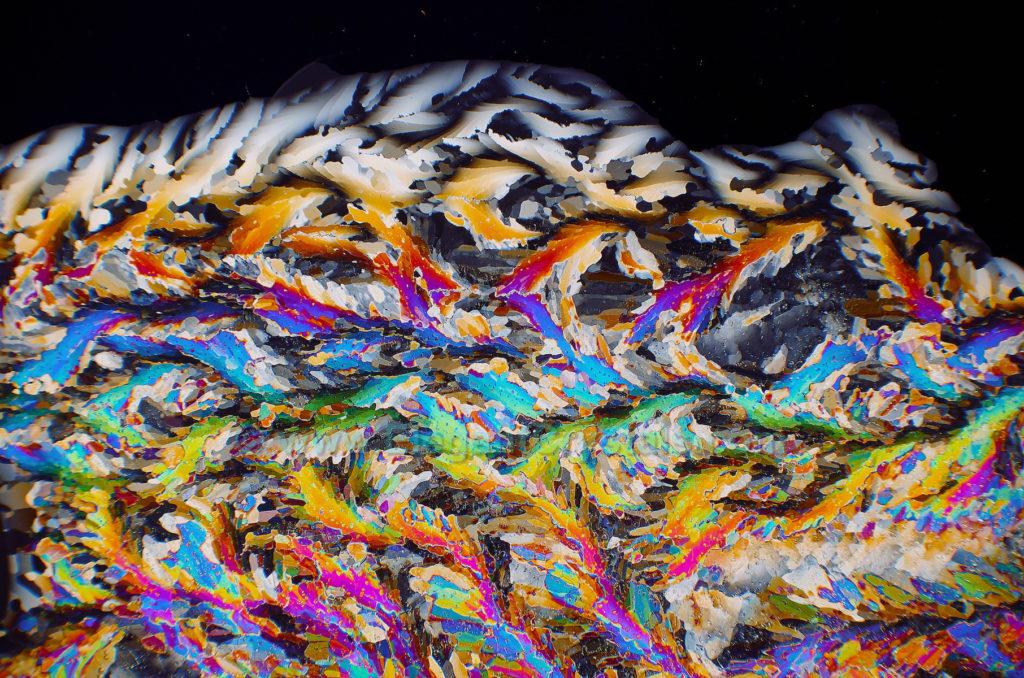
Picture #29
Polarized Light in Ice Crystals
Photo by Tom Wagner
If I didn’t know better, I might think this was a remarkable watercolor painting.
Tom Wagner’s ice photography always yields elegant and graceful designs.
These swirling patterns look like waves, feathers and flowers, all at the same time.
They remind me of M. C. Escher’s interlocking symmetries in his graphic arts.
Quartz rainbows also display this visual versatility.
Each type of pattern has a chapter of its own.
Check out the fractals, feathers, flowers and flames.)
Your personal memories, as well as your social and cultural orientation will determine what types of images you see in crystals, or for that matter, in cloud gazing.
This tendency of human minds to seek out familiar patterns in abstract objects is called “pareidolia.”
(Pronounced PAIR-ih-doh-lee-ah.)
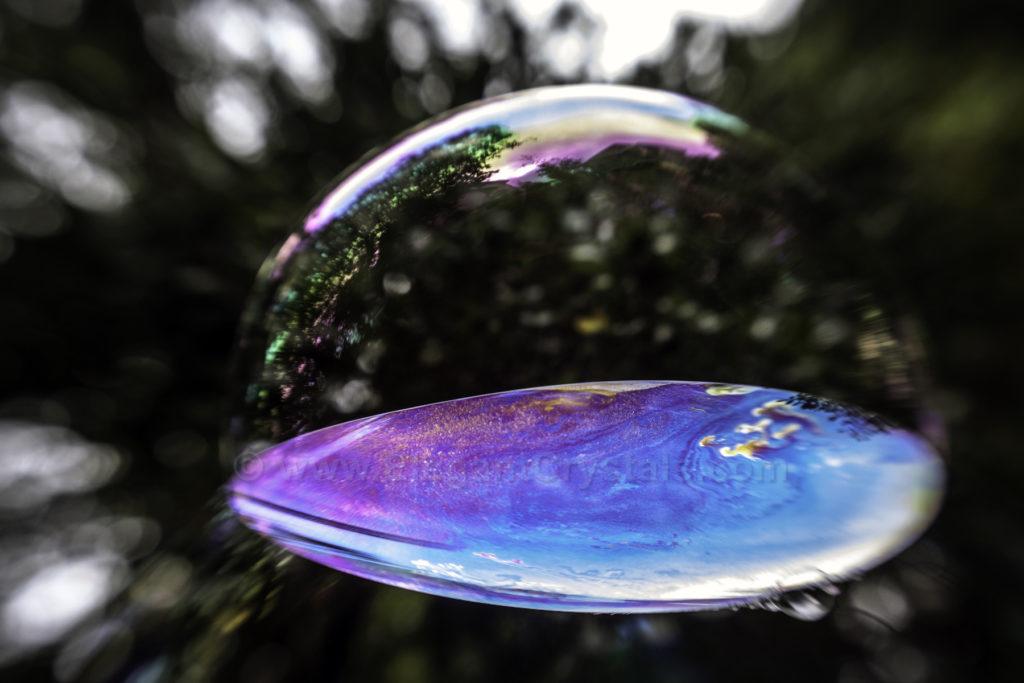
Picture #30
Soap Bubble
Photo by Stefanie Atkinson
Do you need more shimmering rainbows in your life?
Blow some soap bubbles!
There are ways you can even create 10-foot-long soap bubbles with two wooden sticks, a rope and a bucket of Joy soap solution.
Check out my movie about giant soap bubbles on YouTube.
Wavey-Davey and I created 60-foot-long soap bubbles for this epic film called Bubbles of Joy.
These are truly inspiring “thin film” soap and water rainbows.
We figured out how to put the video camera INSIDE the giant bubbles while they were forming.
Then we ran the colored patterns through a computerized kaleidoscope program for a wild ride.

Picture #31
Soap Bubble with Strobe Lighting
Photo by Stefanie Atkinson
Stefanie photographs her soap bubbles with a strobe light for a particular reason.
As the colors light up, the dark background makes the vivid swirling shapes really pop out.
I always use dark backgrounds for my crystal rainbow photos for the same reason.
The pure colors always look so amazing when they seem to be floating in outer space.
This photo caught my eye because the vortex patterns reminded me of so many things.
This is Pareidolia in action. I can see:
Tornadoes
Black holes
Water drains
Electron orbits
Chakra wheels
What do you see in the “Rainbow Tornado?”
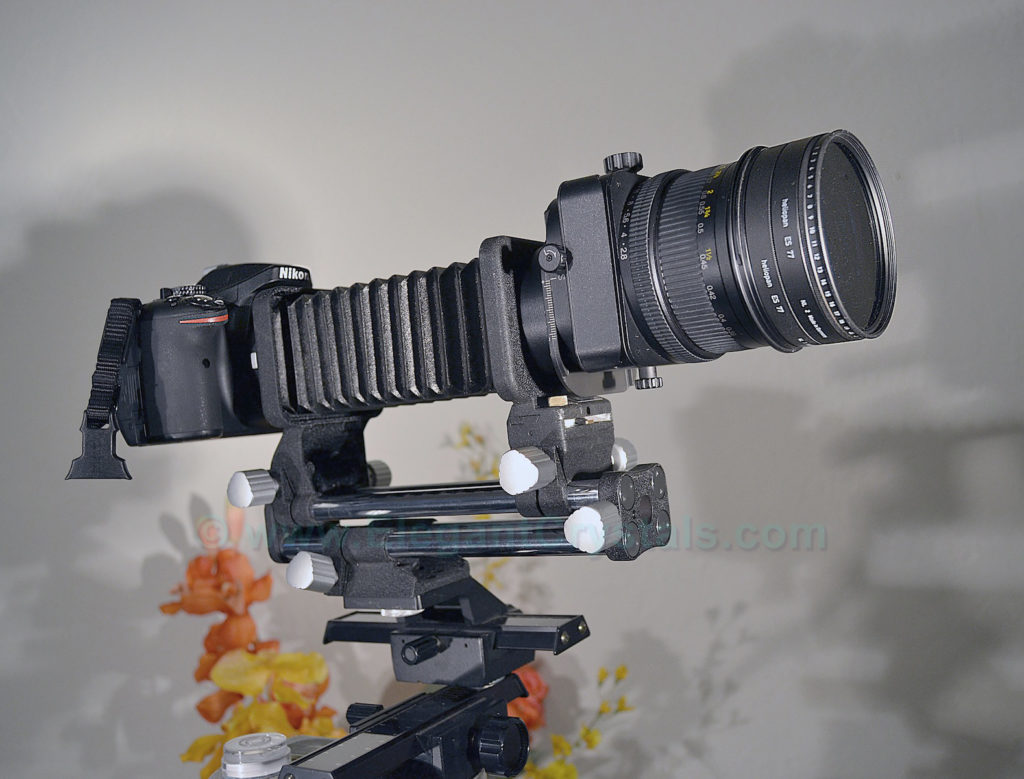
Picture #32
Nikon Camera Body, Bellows Extension, 85mm Perspective Lens
This amazing optical machine sits on a tripod outfitted with “positioning rails.”
I can easily adjust the position of the camera with minute precision.
The camera can slide left to right, near and further, as well as up and down.
The tiny rainbows in my photography often have details finer than a human hair.
This optical gear allows me to move 1/1000th of an inch at a time.
When I use a 200mm Nikkor macro lens, I can shoot 1mm of rainbows and then print it up to 8-feet-long.
In effect, the camera becomes a microscope.
Check out this display of giant crystal rainbows, printed on flat metal sheets:
ElegantCrystals.com/product-category/fine-arts/
I have since upgraded to a Nikon D810 camera body.
Recently, the camera lens went to Royal Camera Service for cleaning and calibration.
What a huge difference that made!
Every decade or so, I get the lenses thoroughly cleaned by one of two terrific repair shops.
These technicians are great!
RoyalCameras.com MidwestCamera.com

Picture #33
Miniature Camera Studio with LED Lights and Floor Lamps
Photographing natural quartz clusters requires many lights, since the stones have a multitude of angled sides.
Each light source will reflect and illuminate only a few facets.
I have used up to 26 lights on a large complicated cluster.
It takes hours, sometimes multiple days, to set up so many lights and get the angles, colors and intensities just right.
Pictures of internal quartz rainbows are much simpler to light up for photography or videography.
A crystal iris rainbow is basically a reflective surface that is relatively flat, with minor curves and bumps.
A single diffuse white light bounces beautiful colors off a rainbow mirror.
The white lightbulb often has a translucent white fabric stretched in front of it to smooth out the intensity of the light.
This diffuse illumination is placed right next to the camera lens, just as close as it can be.
At that point, minor adjustments in the position of the light-source yield fabulously intense colored results.
Sturdy, non-moving equipment is the key to getting sharp pictures
from small rainbow landscapes.
Now let’s look at some of the rainbow wonders that await us on our shimmering, glittery, iridescently beautiful planet.
